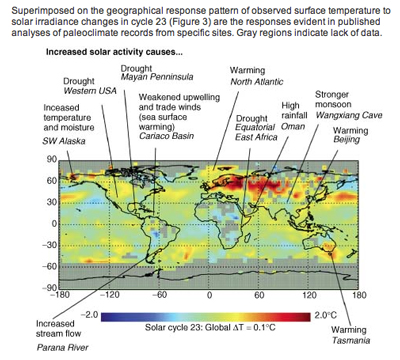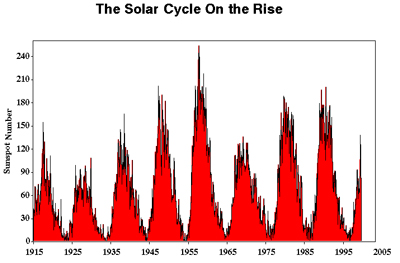New Solar Minimum Ushers In Extreme Cold Climate?
By D.K. Matai

The longer the sun remains quiet, the higher the chances of a prolonged series of cold winters and shorter summers. This is the quietest sun we have seen in almost a century.
The current solar cycle, which began in 1996, was expected to reach a minimum and transition to a new solar cycle in January 2007, post 11 years. It did not, although we have crossed 13+ years and are still counting in January 2010. We are experiencing a historically deep solar minimum!
For those who study the sun, the length of the solar cycle, lasting an average of 11 years, has proven to be the best historical indicator of short-term climate. At the end of these solar cycles, sunspot activity first declines, and then picks up markedly, typically indicating the beginning of a new cycle.
However, the slow return to the next phase of the solar cycle at present may portend a general decline in solar activity. 2008 was a sunspot “bear market” and 2009 was no better according to NASA. There were no sunspots observed on 78% of the days in 2008. To find a year with more blank suns, we have to go all the way back to 1913. Sunspots for 2009 dropped even lower: there were no sunspots on 90% of the days by April.
Solar Irradiance Cycle: Economic Consequences
The Dalton Minimum was a period in history with very low solar activity characterized by prolonged cold conditions between 1796 and 1824. This began with a solar cycle that lasted for 13.6 years, not dissimilar to the present elongated solar cycle. That cycle was then followed by two very inactive solar cycles.
During this time period, there were reports of wide-scale crop failures and food shortages. If similar conditions occur after this present, ongoing, deep solar minimum, and there is a large drop in temperature due to an inactive sun, the world could see further stress on the food supply. Areas that had become available for growing food during the recent short period of warming may become too cold again to grow food over the next two cycles, i.e., two to three decades.
Low Solar Activity

- Courtesy: J. Jokipii, University of Arizona (http://helios.gsfc.nasa.gov) – In the image above, it’s easy to see why the neutral current sheet is often called the “ballerina skirt”. The Parker spiral is indicated by the arrows. The magnetic field is primarily directed outward from the Sun in one of its hemispheres, and inward in the other. This causes opposite magnetic field directions in the Parker spiral. The thin layer between the different field directions is described as the neutral current sheet. Since this dividing line between the outward and inward field directions is not exactly on the solar equator, the rotation of the Sun causes the current sheet to become “wavy”, and this waviness is carried out into interplanetary space by the solar wind. In addition, every eleven years the entire magnetic field of the Sun “flips” — the north magnetic pole of the Sun becomes the south, and vice versa. The flip takes place at solar maximum.
The American Geophysical Union’s journal “Eos” published a paper in late 2009 suggesting that the levels of magnetic activity associated with recent sunspots indicates the sun might be returning to a state of low activity, similar to that of the historic Maunder Minimum between 1645 and 1715, when sunspots became exceedingly rare. During that period, called the Little Ice Age, Europe and North America were subject to bitterly cold winters and very short summers.
Observations of this period suggest that the solar cycle essentially stopped during this time, as very few sunspots were recorded during that time. Global mean temperatures responded accordingly dropping by 0.4°C. The effect was rather pronounced in the Northern Hemisphere, and felt as particularly harsh during the chilly white winters.
The last solar cycle drew to a minimum as expected, leaving the sun with very few sunspots for the past few years. However, what is surprising is the slow pace at which the next solar cycle is starting. That delay set the stage for the Eos paper, which notes that the few sunspots that have been visible are associated with extremely weak changes in solar magnetism. In some models of solar dynamics, this indicates that we are heading for a period similar to the Maunder Minimum, at least as far as the sun is concerned.
Assuming this model is right, can we expect another Little Ice Age, wiping out any impact of the greenhouse gases that have been pumped into the atmosphere?
Solar Cycle Climate Connection

The association between longer solar cycles and cooler climate was first demonstrated in 1991 by two Danish researchers, Egil Friis-Christensen, the director of the Danish Space Centre in Copenhagen, and Knud Lassen, a solar scientist at the Centre, in a paper published in Science. If we compare the global average temperature changes estimated for the Maunder Minimum, -0.4°C, with those that have occurred since the middle of the 20th century, which are about +0.4 to +0.5°C, they even out.
However, Australian geologist David Archibald has found that for every one-year increase in solar cycle length, there is a 0.5°C decline in surface air temperature during the following cycle. The present solar cycle will be 13+ years in length and, using the Archibald relationship, there would likely be a 1.0-1.5°C decline in temperature over the next solar cycle. This possible temperature decrease may not sound like much, but it is thrice as large as the increase in average global temperature during the 20th Century. It is also worth comparing that figure with the warming expected by the end of the 21st century, which the IPCC estimates at over 2°C.
All these numbers indicate that a return to Maunder-Minimum-like conditions could first take us back to very ‘cool cycle’ conditions last experienced between 1880 and 1915, which would be a significant change. Beyond that, a more drastic cooling, similar to that during the Maunder Minimum, could plunge the Earth into another Little Ice Age, but only time will tell us if that is likely.
Henrik Svensmark is the director of the Centre for Sun-Climate Research at the Danish Space Research Institute (DSRI). He studies the effects of cosmic rays on cloud formation. He has suggested that changes in the solar magnetic field associated with sunspots can also have an indirect affect on the climate. These changes influence the number of cosmic rays that reach the earth’s atmosphere — weaker solar magnetic fields mean that more cosmic rays hit the Earth. The cosmic rays form ions in the lower atmosphere that seed clouds, which cool the planet by reflecting sunlight back out, thereby exaggerating the cooling effects of much lower solar activity.
Conclusion: A Buying-Time Opportunity?
The current data is consistent with a decline in the sun’s magnetic field activity, which could potentially end in a sunspot-free period. It is uncertain whether the solar irradiance will rebound soon into a more-or-less normal solar cycle –- or whether it might remain at a low level for decades, analogous to the Maunder Minimum, a period of few sunspots that may have been a principal cause of the Little Ice Age.
This directly affects humanity because sunspot numbers act as a proxy for the amount of radiation sent out by the sun, which can have a significant influence on the Earth’s climate.
According to the climate change establishment, the sun is only one of a large number of factors that influence the climate, and the changes in solar radiance caused by sunspots are asserted by them to have a smaller impact on the climate than that caused by our ever-increasing levels of greenhouse gases.
Nonetheless, even a relatively small cooling effect caused by reduced solar activity, may buy humanity valuable time in coming to grips with greenhouse gases we are pumping into the atmosphere, at least when it comes to Earth’s average temperature increase.
Ocean acidification and long-term damage to the environment are not addressed via the possibility of much reduced solar activity.
Key Question: For how many years must the planet cool, and how cold must it get, before we are able to say that the planet is no longer warming?
———-
***Posted February 10th, 2010

